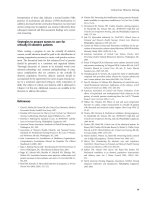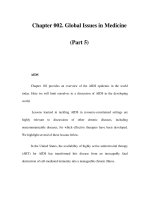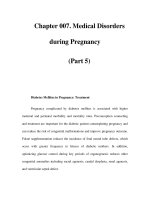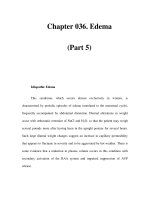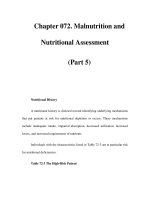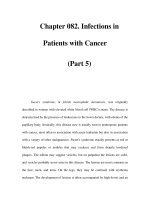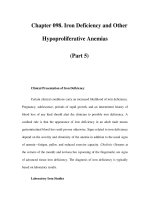Case Files Neurology - part 5 ppsx
Bạn đang xem bản rút gọn của tài liệu. Xem và tải ngay bản đầy đủ của tài liệu tại đây (357.4 KB, 50 trang )
Alzheimer patients present with a primary cortical dementia with memory
impairment as a predominant feature. Parkinsonian features are not uncommon
in AD, but often will show in advanced disease when cognitive impairment is
severe. In addition, AD patient can inadvertently be treated with antipsychotics
for associated behavioral disturbances and develop drug-induced parkinsonism.
With Parkinson disease, patients can also have a dementia, but it is predomi-
nantly subcortical (slowed thought processes, retrieval, attention, and concen-
tration) and is usually not a predominant clinical feature of the disease.
CNS infections such as HIV encephalitis or chronic fungal meningitis can
present with slowly progressive dementia and motor dysfunction. Often the
dementia and motor dysfunction are more global and include multiple cortical
and subcortical deficits, extrapyramidal and pyramidal dysfunction, and a
more rapid clinical course. Normal pressure hydrocephalus and cerebrovascu-
lar disease (particularly ischemic disease of the deep white matter) typically
presents as what is called “lower body parkinsonism” with early gait and bal-
ance problems, lower body akinesia/bradykinesia, little or no tremor. Urinary
abnormalities and the executive frontal lobe dysfunction are common. For
both these disorders, neuroimaging often shows characteristic abnormalities.
APPROACH TO DIFFUSE LEWY BODY DEMENTIA
Definitions
Constructional apraxia: Difficulty in performing tasks involved with con-
struction, for example, drawing a five-pointed star.
Executive function: Mental capacity to control and plan mental skills, the
ability to sustain or flexibly direct attention, the inhibition of inappro-
priate behavioral or emotional responses, the planning of strategies for
future behavior, the initiation and execution of these strategies, and the
ability to flexibly switch among problem-solving strategies. It is medi-
ated by the prefrontal lobes of the cerebral cortex.
Ideomotor apraxia: Disturbance of voluntary movement in which a per-
son cannot translate an idea into movement.
REM-related disorders: A parasomnia involving dissociation of the char-
acteristic stages of sleep. The major feature is loss of motor inhibition
leading to a wide spectrum of behavioral release during sleep, that is,
“acting out dreams.”
Clinical Approach
Diffuse Lewy body dementia (DLBD) is felt to represent the second most
common cause of dementia in developed countries in the Western Hemisphere.
It accounts for 10–20% of dementias; however, the sensitivity and specificity of
DLBD and common dementias are poor because pathology and clinical features
CLINICAL CASES 183
can overlap between DLBD and dementias, such as AD. In fact, 40% of AD
patients have the pathologic alterations felt to be specific for DLBD, the Lewy
body. Epidemiologic studies are limited but suggest that men are more affected
than woman, and the usual onset is in late 50’s and beyond.
Clinical History and Features
DLBD is a progressive degenerative dementia but can overlap with other
parkinsonian dementias and primary Alzheimer dementia, clinically and
pathologically (Table 21–1 for diagnostic features of DLBD). However, when
dementia precedes motor signs, particularly with visual hallucinations and
episodes of reduced responsiveness, the diagnosis of DLBD should be consid-
ered. The following clinical features help distinguish DLBD from Alzheimer
dementia: (1) fluctuations in cognitive function with varying levels of alert-
ness and attention, (2) visual hallucinations, (3) parkinsonian motor features
that appear relatively early in DLBD. Cognitive impairment in DLBD is char-
acterized by more executive dysfunction and visual-spatial impairment rather
than the anterograde memory loss of AD. It is not unusual for someone with
DLBD to have a relative severe dementia by history, but to have relatively pre-
served delayed recall with severe constructional dyspraxia. This combination
is virtually never seen in AD. When parkinsonism precedes cognitive dys-
function by more than 2 years, the disorder is referred to as Parkinson disease
dementia. Although this differentiation seems largely semantic, knowing this
clinical presentation is useful practically (Table 21–2). Other suggestive fea-
tures of DLBD are nonvisual hallucinations, delusions, unexplained syncope,
REM-sleep disorders, neuroleptic sensitivity.
Pathology
Frederick Lewy first described Lewy bodies (LBs) in 1914, which are cyto-
plasmic inclusions of the substantia nigra neurons in patients with idiopathic
Parkinson disease (PD). By the 1960s, pathologists had described patients
with dementia who had LBs of the neocortex. It was not until the mid 1980s,
when sensitive immunocytochemical methods to identify LBs were devel-
oped, that dementia with LBs (DLB) was then recognized as being far more
common than previously thought. However, there is considerable controversy
at this point over whether DLB in PD are two different conditions or just part
of a spectrum disorder with common underlying pathology.
Diagnostic Studies
Laboratory studies should include the routine dementia evaluation, including a
chemistry panel, complete blood count (CBC), thyroid studies, vitamin B
12
lev-
els, syphilis serology, Lyme disease serology, or HIV testing, when appropriate.
184 CASE FILES: NEUROLOGY
CLINICAL CASES 185
Table 21–1
DIAGNOSTIC FEATURES OF DEMENTIA WITH LEWY BODIES
1. Central feature (essential for a diagnosis of possible or probable DLB):
• Dementia defined as progressive cognitive decline of sufficient magnitude to
interfere with normal social or occupational function; prominent or persistent
memory impairment may not necessarily occur in the early stages but is usually
evident with progression; deficits on tests of attention, executive function, and
visuospatial ability may be especially prominent
2. Core features (two core features are sufficient for a diagnosis of probable DLB,
one for possible DLB)
• Fluctuating cognition with pronounced variations in attention and alertness
• Recurrent visual hallucinations that are typically well formed and detailed
• Spontaneous features of parkinsonism
3. Suggestive features (one or more of these in the presence of one or more core fea-
tures is sufficient for a diagnosis of probable DLB; in the absence of any core fea-
tures, one or more suggestive features is sufficient for a diagnosis of possible DLB;
probable DLB should not be diagnosed on the basis of suggestive features alone)
• REM-sleep behavior disorder
• Severe neuroleptic sensitivity
• Low dopamine-transporter uptake in basal ganglia demonstrated by SPECT or
PET imaging
4. Supportive features (commonly present but not proven to have diagnostic specificity)
• Repeated falls and syncope
• Transient, unexplained loss of consciousness
• Severe autonomic dysfunction
• Hallucinations in other modalities
• Systematized delusions
• Depression
• Relative preservation of mesial temporal lobe structures on computed
tomography/magnetic resonance imaging
• Reduced occipital activity on SPECT/PET
• Low uptake MIBG myocardial scintigraphy
• Prominent slow wave activity on EEG with temporal lobe transient sharp waves
DLB, dementia with Lewy bodies; EEG, electroencephalograph; MIBG, metaiodobenzylguani-
dine; PET, positron emission tomography; REM, rapid eye movement; SPECT, single-photon
emission computed tomography.
Source: McKeith IG, Dickson DW, Lowe J, et al. Diagnosis and management of dementia with
Lewy bodies: third report of the DLB Consortium. Neurology 2005;65:1863–1872.
Imaging studies are important to evaluate for other conditions that can
mimic this disorder (vascular dementia, tumor, normal pressure hydrocephalus,
etc). Patients with DLBD usually have less hippocampal atrophy than patients
with AD (but more than control subjects). Whether this difference is clinically
useful is under investigation, as is the diagnostic utility of functional imaging.
Single-photon emission CT scanning or positron emission tomography scanning
can show decreased occipital lobe blood flow or metabolism in DLB but not in
AD. Reduced dopamine transporter activity in the basal ganglia is seen with
positron emission tomography scanning or single-photon emission CT scanning.
Other Tests
In certain circumstances, neuropsychologic testing is helpful to differentiate
DLB from AD and to establish a baseline for future comparison. Patients with
DLB can have changes on electroencephalography earlier than patients with
AD, but whether this difference is diagnostically useful is not clear.
Cerebrospinal fluid (CSF) examination is not required in routine cases, but
patients with AD have higher levels of tau protein in their CSF than patients
with DLB. Patients with both LB variant-AD have intermediate values. CSF
levels of beta-amyloid are lower than normal in DLB, AD, and LBV-AD.
However, CSF beta-amyloid levels in DLB, LBV-AD, and AD do not differ
from each other.
Treatment
There are no medications that have been shown to delay the degeneration of
this disorder. Symptomatically, the anticholinesterase medications (i.e.,
rivastigmine, donepezil, and galanthamine) have been demonstrated to have
186 CASE FILES: NEUROLOGY
Table 21–2
CLINICAL PHENOMENOLOGY OF DEMENTIA WITH LEWY BODIES
• Comparison to PD
– Less severe parkinsonism
– Less tremor
– More postural instability
• Comparison to AD
– More visuospatial deficit
– Less language, memory encoding deficit
• Comparison to AD & PD
– More fluctuation and hallucinations
AD, Alzheimer disease; PD, Parkinson disease.
cognitive/behavioral symptom improvement. The cortical cholinergic deple-
tion in DLB is actually much more severe than AD and so appears to be more
responsive to treatment. Cognitive and behavioral symptoms have been shown
to improve with this class of medications, however, not depression.
Neuroleptic agents should be used with extreme caution in these patients.
Patients, often treated for behavioral issues with neuroleptics, have been
described to have disastrous responses to this class of medicines, even when
using “atypical antipsychotics.” For severe depression, electroconvulsive
therapy has been shown to be effective and safe. In addition, parkinsonian
motor signs have also been shown to improve with ECT.
Comprehension Questions
[21.1] A 68-year-old woman is diagnosed with dementia with Lewy bodies.
Her medications are mixed up with her husband’s medication bottles.
Which of the following is most likely to be her husband’s medication?
A. Rivastigmine
B. Donepezil
C. Haloperidol
D. Galanthamine
[21.2]. A 61-year-old man is brought into the doctor’s office for memory loss
and confusion. Which of the following symptoms are most suggestive
of Alzheimer disease as opposed to dementia with Lewy bodies?
A. Visual hallucinations
B. Dramatic fluctuations in clinical condition
C. Early anterograde memory loss
D. Early shuffling gait
[21.3] A 73-year-old man is noted to have a slow onset of cognitive deficits. The
physical examination reveals no obvious etiology. Which of the follow-
ing imaging findings are most suggestive of dementia with Lewy bodies?
A. Medial temporal lobe atrophy
B. Parietal temporal hypometabolism
C. Atrophy of the midbrain
D. Occipital lobe hypometabolism
Answers
[21.1] C. Haloperidol is a dopamine-receptor blocking agent that can have
severely deleterious consequences in this disorder. The other three are anti-
cholinesterases and have evidence for the use presented in the literature.
[21.2] C. Cognitive impairment in DLB is characterized by more executive
dysfunction and visuospatial impairment more than the anterograde
memory loss of AD.
CLINICAL CASES 187
[21.3] D. Occipital lobe hypometabolism is most typical of DLB. Medial
temporal lobe atrophy and parietal temporal hypometabolism are char-
acteristic of AD. Atrophy of the midbrain is characteristic of progres-
sive supranuclear palsy.
REFERENCES
Ballard C, Grace J, McKeith I, et al. Neuroleptic sensitivity in dementia with Lewy
bodies and Alzheimer’s disease. Lancet 1998;351:1032–1033.
Bonner LT, Tsuang DW, Cherrier MM, et al. Familial dementia with Lewy bodies
with an atypical clinical presentation. J Geriatr Psychiatry Neurol
2003;16:59–64.
Geser F, Wenning GK, Poewe W, et al. How to diagnose dementia with Lewy bod-
ies: state of the art. Mov Disord 2005 Aug;20(suppl 12):S11–20.
Korczyn AD, Reichmann H. Dementia with Lewy bodies. J Neurol Sci
2006;248:3–8.
McKeith IG, Dickson DW, Lowe J, et al. Diagnosis and management of dementia
with Lewy bodies: third report of the DLB Consortium. Neurology 2005;65:
1863–1872.
Miyasaki JM, Shannon K, Voon V, et al; Quality Standards Subcommittee of the
American Academy of Neurology. Practice parameter: evaluation and treatment
of depression, psychosis, and dementia in Parkinson disease (an evidence-based
review): report of the Quality Standards Subcommittee of the American
Academy of Neurology. Neurology 2006;66:996–1002.
188 CASE FILES: NEUROLOGY
CLINICAL PEARLS
❖ Lewy bodies are associated with a number of clinical syndromes,
including Alzheimer’s dementia and Parkinson disease.
❖ The typical clinical syndrome of DLB is relatively specific for the
Lewy body pathology, but the converse is not necessarily so and
can constitute part of a spectrum of synucleinopathies.
❖ Compared to AD, DLB is associated with a greater loss of acetyl-
choline and a smaller loss of acetylcholine (ACh)-receptors
❖ Levodopa can be effective for the parkinsonism but is often not very
rewarding for behavioral or cognitive dysfunction.
❖ REM-related behavior disorders can be one of the first symptoms
of DLBD, prior to the onset of significant cognitive or motor
disturbance.
❖
CASE 22
A 48-year-old man complained of “numbness and stiffness” in his arms for the
past 4 months. His gait has gradually deteriorated because of unsteadiness. On
examination the patient appeared older than his stated age. His hair was nearly
completely gray. There was slight limitation of head movement to either side,
but no pain with neck extension. His tongue was red and depilated. His gait was
broad based, and he was unable to walk a straight line. He was able to stand with
his feet together with his eyes open, but he nearly fell when his eyes were
closed. He had normal arm coordination but was ataxic on the heel-knee-shin
maneuver. Deep tendon reflexes (DTRs) were 3+ in the arms, trace at the
knees, and absent at the ankles. Both plantar responses were extensor. There
was a 2+ jaw jerk and a positive snout reflex. There was a stocking decrease
in sensation and a marked decrease in vibration and joint position sense in the
toes and ankles. Cranial nerves were normal, and there were mild problems
with memory and calculation. T2-weighted MRI of the brain demonstrated
extensive areas of high-intensity signal in the periventricular white matter.
MRI of the spine showed a hyperintense signal along the posterior column of
the spinal cord.
◆
What is the most likely diagnosis?
◆
What is the next diagnostic step?
◆
What is the next step in therapy?
ANSWERS TO CASE 22: Subacute Combined
Degeneration of Spinal Cord
Summary: This is a 48-year-old patient with a progressive gait disorder char-
acterized by sensory ataxia caused by impaired position sense and spasticity.
His examination is significant for both peripheral and central nervous system
involvement, primarily affecting the white matter fibers of the posterior
columns of the spinal columns and pyramidal tracts and large myelinated
peripheral nerve affecting coordination and muscle tone.
◆
Most likely diagnosis: Vitamin B
12
deficiency
◆
Next diagnostic step: Vitamin B
12
level and if positive, subsequent
testing to determine the source of B
12
malabsorption
◆
Next step in therapy: Intramuscular vitamin B
12
Analysis
Objectives
1. Understand the range of pathologic and clinical manifestations of
vitamin B
12
deficiency.
2. Know the differential diagnosis of vitamin B
12
deficiency.
3. Understand the types of tests to confirm the diagnosis and etiology of
vitamin B
12
deficiency.
4. Be aware of the proper mode of repletion of vitamin B
12
.
Considerations
The pertinent features of this case include the presentation, unsteadiness of gait,
and numbness and stiffness. The physical examination helps localize the
pathology. There was a stocking decrease in sensation, specifically vibration
and joint position sense, which strongly suggests a neuropathy involving myeli-
nated fibers. Involvement of the dorsal columns of the spinal cord, at or above
the lumbar level is also a possibility. The pathologically increased reflexes in
the arms along with the presence of primitive reflexes are “upper motor neuron
signs” and suggest involvement of the corticospinal tract above the level of the
cervical spinal cord. In this case, one would expect increased reflexes in the
legs also, unless there is also a coexistent neuropathy. The ataxic heel knee to
shin maneuver, also points to aberrant input to the cerebellum, which comes
through large fibers. The mild problems on mental status examination indicate
a cortical disorder. All of these findings suggest involvement at multiple levels
of the nervous system. The imaging study confirms involvement of myelinated
regions in the spinal cord, specifically the dorsal columns and in the brain.
190 CASE FILES: NEUROLOGY
Assuming all these signs/symptoms are manifestations of a single entity, a sys-
temic disease should be considered, such as HIV-1 associated vacuolar
myelopathy, Lyme disease, multiple sclerosis, neurosyphilis, or vitamin B
12
deficiency. Neuropathic conditions would not be expected to give upper motor
neuron signs. Another clue on physical diagnosis is the abnormal tongue and
prematurely graying hair.
APPROACH TO SUBACUTE COMBINED
DEGENERATION OF THE SPINAL CORD
Spinal cord diseases are common, and many are treatable if discovered early.
The spinal cord is a tubular structure originating from the medulla of the brain
and extending through the bony spine to the coccyx. Ascending sensory and
descending motor white matter tracts are located peripherally; posterior
columns govern joint position, vibration and pressure, lateral spinothalamic
tracts pain and temperature, and ventral corticospinal tracts carry motor signals.
Vitamin B
12
Deficiency
Vitamin B
12
deficiency usually presents as paresthesias in the hands and feet
and loss of vibratory sense. There is a diffuse effect on the spinal cord, prima-
rily the posterior lateral columns, explaining the early loss of vibratory sense.
Late in the course, optic atrophy and mental changes as well ataxia can occur.
The macrocytic anemia is common.
Cyanocobalamin is a compound that is metabolized to a vitamin in the
B complex commonly known as vitamin B
12
. Vitamin B
12
is the most chemi-
cally complex of all the vitamins. The structure of B
12
is based on a corrin ring,
which is similar to the porphyrin ring found in heme, chlorophyll, and
cytochrome. The central metal ion is cobalt (Co). Once metabolized, cobal-
amin is a coenzyme in many biochemical reactions, including DNA synthesis,
methionine synthesis from homocysteine, and conversion of propionyl into
succinyl coenzyme A from methylmalonate. Dietary cobalamin (Cbl),
obtained through animal foods, enters the stomach bound to animal proteins.
Absorption requires many factors including stomach acid, R-protein, and
intrinsic factor from parietal cells, and the distal 80 cm of the ileum for trans-
port. Interference in any of these points can lead to malabsorption of vitamin
B
12
. In addition there are a number of inborn errors of metabolism that can
both interfere with the absorption and action of vitamin B
12
. The most com-
mon cause of vitamin B
12
deficiency is malabsorption because of pernicious
anemia, a condition where antibodies are generated to the parietal cells of the
stomach, and the necessary proteins are not available. There are many other
causes, however, that should be considered.
Pathologically, in experimental subacute combined degeneration (SCD),
there is edema and destruction of myelin. Thus, the clinical presentation of SCD
CLINICAL CASES 191
is caused by dorsal column, lateral corticospinal tract, and sometimes lateral
spinothalamic tract dysfunction. The initial symptoms are usually paresthesia in
the hands and feet. This condition can progress to sensory loss, gait ataxia, and
distal weakness, particularly in the legs. If the disease goes untreated, an ataxic
paraplegia can evolve. Specific findings on examination are loss of vibratory
and joint position sense, weakness, spasticity, hyperreflexia, and extensor plan-
tar responses. The syndrome of sensory loss as well as spastic paresis associated
with pathologic lesions in the dorsal columns and lateral corticospinal tracts is
referred to as subacute combined degeneration. There are also effects on other
body systems, most conspicuously hematologic with the macrocytic anemia.
Differential Diagnosis
The manifestations of vitamin B
12
deficiency are noted in Table 22–1. The dif-
ferential diagnosis for progressive spastic paraplegia includes degenerative,
demyelinating, infectious, inflammatory, neoplastic, nutritional, and vascular dis-
orders. HIV-1 associated vacuolar myelopathy, Lyme disease, multiple sclerosis
neurosyphilis, toxic neuropathy, Friedreich ataxia, and vitamin E deficiency.
192 CASE FILES: NEUROLOGY
Table 22–1
CLINICAL MANIFESTATIONS OF VITAMIN B
12
DEFICIENCY
Neurologic
• Paresthesia
• Peripheral neuropathy
• Combined systems disease (demyelination of dorsal columns and corticospinal
tract)
Behavioral
• Irritability, personality change
• Mild memory impairment, dementia
• Depression
• Psychosis
General
• Lemon-yellow waxy pallor, premature whitening of hair
• Flabby bulky frame
• Mild icterus
• Blotchy skin pigmentation in dark-skinned patients
Cardiovascular
• Tachycardia, congestive heart failure
Gastrointestinal
• Beefy, red, smooth, and sore tongue with loss of papillae that is more
pronounced along edges
Hematologic
• Megaloblastic anemia; pancytopenia (leukopenia, thrombocytopenia)
The differential diagnosis of SCD is broad, but B
12
deficiency should be consid-
ered in any patient with progressive sensory symptoms or weakness.
Laboratory Confirmation
Testing for vitamin B
12
deficiency includes a direct assay of the vitamin as well
as looking at the indirect effect of abnormal reactions resulting in altered
metabolite levels. The definitions of Cbl (vitamin B
12
) deficiency are as fol-
lows: Serum Cbl level <150 pmol/L on two separate occasions OR serum Cbl
level <150 pmol/L AND total serum homocysteine level >13 µmol/L OR
methylmalonic acid >0.4 µmol/L (in the absence of renal failure and folate and
vitamin B
6
deficiencies). The hematologic manifestations of vitamin B
12
defi-
ciency can be mimicked by folate deficiency, but this does not mimic the neu-
rologic manifestations. In addition, the multiple organ systems and subsystems
affected are highly variable from patient to patient.
Confirmatory effects of the anatomic and physiologic consequences of B
12
deficiency involve nerve conduction studies and MRI. Few reported cases of MR
imaging of SCD exist. Findings in these cases include modest expansion of the
cervical and thoracic spinal cord and increased signal intensity on T2-weighted
images, primarily in the dorsal columns and lateral pyramidal tracts (Fig. 22–1).
CLINICAL CASES 193
Figure 22–1. Degeneration of spinal cord in subacute combined degeneration
on microscopy. (With permission from Lichtam MA, Beutler E, Kaushansky K,
et al. Williams hematology, 7th ed. New York: McGraw-Hill; 2005: Fig. 39–19.)
194 CASE FILES: NEUROLOGY
Treatment
Treatment of vitamin B
12
deficiency involves administering the vitamin in a fash-
ion to bypass the pathologic steps in the transport process. This usually involves
intramuscular administration of the vitamin, first to build up stores and then on a
monthly basis. Specifically, 1000 µg/d for 1 week, then 1000 µg/wk for 1 month.
Then 1000 µg/mo until the cause of deficiency is corrected, or for life in the case
of pernicious anemia. This is effective for all forms of deficiency. There are also
methods of oral administration that are sometimes effective. Treatment can
reverse or stop most if not all of the sequelae of vitamin B
12
deficiency.
Comprehension Questions
[22.1] Vitamin B
12
repletion by which of the following routes will be effec-
tive in virtually all causes of B
12
deficiency?
A. Concentrated oral vitamin B
12
B. Nasal vitamin B
12
administration
C. A diet high in red meats
D. Intramuscular B
12
administration
[22.2] Which feature of the clinical picture might make you most suspicious
of vitamin B
12
deficiency as a cause for a patient with spastic paresis
and sensory loss?
A. Severe signs and symptoms developing over 1 day
B. Loss of pain and temperature sensation in excess of vibration and
joint position sense
C. Severe weakness with spasticity and loss of all sensory modalities
in the legs with a neurogenic bladder
D. Anemia with an increased mean corpuscular volume (MCV) and
hypersegmented polymorphonuclear cells
[22.3] Which feature of vitamin B
12
deficiency is not mimicked in at least
some cases of typical multiple sclerosis?
A. Loss of vibration and joint position sensation in the feet
B. Positive Babinski signs
C. Slowed nerve conduction velocities
D. Increased signal on T2 imaging in the spinal cord
Answers
[22.1] D. The other forms require some aspect of the body’s B
12
absorption system.
[22.2] D. Megaloblastic anemia is the characteristic finding in vitamin B
12
deficiency. The clinical picture usually develops over months, not
days. Usually all limbs are involved to some extent, and severe
involvement of the legs and not arms makes one consider an anatomic
lesion in the spinal cord. In addition, vibration and joint position sense
are usually involved much more than pain and temperature.
CLINICAL CASES 195
[22.3] C. Multiple sclerosis is by and large a disorder of the central nervous
system and does not affect peripheral nerve conduction studies.
REFERENCES
Andrès E, Loukili NH, Noel E, et al. Vitamin B
12
(cobalamin) deficiency in elderly
patients. CMAJ 2004;171(3):251–259.
Healton EB, Savage DG, Brust JC, et al. Neurological aspects of cobalamine defi-
ciency. Medicine 1991;70:229–244.
Larner AJ, Zeman AZJ, Allen CMC, et al. MRI appearances in subacute combined
degeneration of the spinal cord due to vitamin B
12
deficiency. J Neurol
Neurosurg Psychiatry 1997;62:99–100.
Ravina B, Loevner LA, Bank W. MR findings in subacute combined degeneration
of the spinal cord: a case of reversible cervical myelopathy. AJR Am J
Roentgenol 2000;174:863–865.
Reynolds E. Vitamin B
12
, folic acid, and the nervous system. Lancet Neurol 2006
Nov;5(11):949–960.
Scalabrino G. Cobalamin (vitamin B[12]) in subacute combined degeneration and
beyond: traditional interpretations and novel theories. Exp Neurol
2005;192:463–479.
CLINICAL PEARLS
❖ Vitamin B
12
deficiency typically affects peripheral nerves, as well
as the dorsal columns and lateral corticospinal tracts giving a
syndrome of spasticity with ataxia as a result of loss of joint posi-
tion sense. There are many more neurologic signs, however, that
can variably be seen.
❖ Nerve conduction studies can show both demyelinating and dener-
vation features in vitamin B
12
deficiency.
❖ The most common cause of vitamin B
12
deficiency is pernicious
anemia.
❖ Intramuscular administration of vitamin B
12
is the most effective
way of treating this condition and can reverse or stop the neuro-
logic features.
❖ Vitamin B
12
deficiency is associated with a macrocytic anemia.
This page intentionally left blank
❖
CASE 23
A 23-year-old graduate student was studying late at night for an examination.
As he looked at his textbook, he realized he was having difficulty reading
through his left eye. When he covered his left eye, visual input through the
right eye seemed normal. However, when he covered his right eye, his visual
input was blurred. He also noted left ocular pain when he moved his eyes. He
had no pain in his right eye and had no headache, dizziness, pain, or numb-
ness. Aside from his left monocular visual compromise, he had no symptoms.
Further, he had no history of any previous symptoms. He decided to go to
sleep and went to the infirmary the following day.
◆
What is the most likely diagnosis?
◆
What is the next diagnostic step?
◆
What is the next step in therapy?
ANSWERS TO CASE 23: Optic Neuritis
Summary: A 23-year-old man suddenly developed left monocular visual com-
plaints and left eye pain with ocular movement. Otherwise, he had no symptoms.
◆
Most likely diagnosis: Optic neuritis.
◆
Next step in therapy: Therapy may or may not be indicated. Depending
on the evaluation, a short course of steroids might prove helpful.
Analysis
Objectives
1. Understand the differential diagnosis of monocular visual compromise.
2. Understand the evaluation for optic neuritis.
3. Understand the relationship between optic neuritis and multiple sclerosis.
4. Understand when and how to treat optic neuritis.
Considerations
Optic neuritis usually is associated with an acute, usually unilateral, loss of
visual acuity or visual field or both. Ninety percent of patients with optic neuri-
tis have ocular pain, usually with eye movement. This disturbance can occur at
any age but usually occurs in young adults, younger than 40 years old. Within
several weeks following onset of symptoms, approximately 90% of patients
with optic neuritis experience visual improvement to normal vision, or only mar-
ginal compromise. Visual recovery can continue for months, sometimes for as
long as 1 year. Some patients have residual deficits in contrast sensitivity, color
vision, depth perception, light brightness, visual acuity, or visual field. The
patient in this case should see a physician, have a careful neurologic assessment,
and have blood studies. Brain imaging might be indicated. Lumbar puncture for
assessment of possible demyelinating disease might also be necessary.
APPROACH TO OPTIC NEURITIS
Definitions
Optic neuropathy: Unilateral or bilateral impairment of optic nerve func-
tion. The diagnosis is usually made clinically. Differential diagnosis:
congenital, hereditary, infectious, inflammatory, infiltrative, ischemic,
demyelinating (optic neuritis), and compressive etiologies.
Optic neuritis: A general term for idiopathic, inflammatory, infectious, or
demyelinating optic neuropathy.
Anterior optic neuritis: Also called papillitis. This condition refers to
swelling of the optic nerve.
198 CASE FILES: NEUROLOGY
Retrobulbar neuritis: Also called posterior optic neuritis. Patients have
symptoms because of compromise of the optic nerve, but the optic nerve
appears normal.
Clinical Approach
Optic neuritis is defined as inflammation of the optic nerve. It is one of the
causes of acute loss of vision associated with pain mainly because of demyeli-
nation and can be idiopathic and isolated. However, this disease has a very
strong association with multiple sclerosis (MS).
Epidemiology
Whites of northern European descent are affected eight times more frequently
than blacks and Asians. Whites of Mediterranean ancestry are at intermediate
risk. African blacks and Asians are rarely affected. In the United States, the
male-to-female ratio for optic neuritis is 1:1.8. The mean age of onset is
approximately 30 years, with most patients presenting from 20–40 years of age.
The condition is rare in children and is usually related to a postinfectious or
parainfectious demyelination. Optic neuritis in children is less likely to
progress to MS, but, in some reports, it has a worse prognosis for full vision
recovery. In patients older than 50 years of age, optic neuritis is less common
and can be mistaken for ischemic optic neuropathy, which is more common in
persons in this age group.
Etiologies and Clinical Presentation
Patients with optic neuritis experience an acute, usually unilateral loss of
visual acuity or compromise of visual field; sometimes, they have both a loss
of acuity and field compromise. These symptoms usually occur suddenly but
can worsen over the next several days to weeks. Usually, eye movement
causes pain in the involved eye.
Examination reveals decreased visual acuity or visual field compromise (or
both), and an afferent pupillary defect. This deficit is associated with a dilated
pupil in the involved eye. This dilated pupil does not constrict well to direct
light and, when light is directed into that eye, the pupil of the other (normal) eye
does not contract, signifying afferent compromise of light to the involved eye.
However, when light is directly shined into the normal eye, not only does
the pupil of that normal eye constrict, but the (already dilated) pupil of the
involved eye constricts, signifying that the efferent output to the pupil of the
involved eye is normal (Fig. 23–1).
The etiology of optic neuritis is usually idiopathic or caused by demyelinat-
ing disease. Sometimes, optic neuritis is caused by other disorders, such as noted
in Table 24–1 of case 24. Indications for laboratory testing depends on the
CLINICAL CASES 199
200 CASE FILES: NEUROLOGY
4 mm
Decreased reaction of both pupils
B. ABNORMAL RIGHT EYE
4 mm
5 mm
Normal reaction of both pupils
A. BOTH EYES NORMAL
Light on Normal Eye
Afferent
pupillary
defect
Normal
eye
Diffuse Illumination
5 mm
2 mm
Normal reaction of both pupils
2 mm
2 mm 2 mm
Normal reaction of both pupils
C. ABNORMAL RIGHT EYE
Afferent
pupillary
defect
Normal
eye
Figure 23–1. Afferent pupillary defect. (With permission from Riordan-Eva P,
Hoyt WF, Neuroophthalmology. In: Riordan-Eva P, Asbury T, Whitcher JP,
General Ophthalmology, 16th ed. New York: McGraw-Hill; 2003: Fig. 14–32,
p 268.)
patient’s other symptoms, or lack thereof. At issue is whether the patient has MS,
which often requires a thorough evaluation to rule out other causes. Many neu-
rologists do not obtain any tests but, instead, follow the patient. Others pursue
chest radiograph, blood studies (e.g., syphilis, collagen vascular disease, serum
chemistries, complete blood count, sedimentation rate, serum protein elec-
trophoresis), and lumbar puncture for assessment of possible demyelinating dis-
ease. MRI of the brain (with and without contrast) in patients with optic neuritis
is usually not necessary for the diagnosis but is a powerful predictor of the
patient developing MS. Absence of pain or a normal MRI of the brain suggests
decreased risk.
The 5-year cumulative probability of clinically definite MS in patients with
optic neuritis is 30%. If, at the onset of symptoms, the MRI of the brain reveals
no lesions, this risk decreases to 16%. If the patient has three or more lesions
on their MRI, the risk increases to 51 percent. Aside from three or more lesions
on the MRI suggesting increased risk of developing MS, other factors that
also suggest increased risk include prior nonspecific neurologic symptoms;
increased immunoglobulins or oligoclonal bands in the cerebrospinal fluid; pre-
vious optic neuritis; testing positive for human leukocyte antigens HLA-DR2
or HLA-B7.
Diagnosis
The diagnosis of optic neuritis is usually made on clinical grounds, supple-
mented by ophthalmologic examination findings. However, in atypical cases
(e.g., prolonged or severe pain, lack of visual recovery, atypical visual-field
loss, evidence of orbital inflammation), MRI is used to further characterize
and to exclude other disease processes. The real contribution of imaging in the
setting of optic neuritis is made by imaging the brain, not the optic nerves
themselves. This is because the most valuable predictor for the development
of subsequent MS is the presence of white matter abnormalities. In various
studies, 27–70% of patients with isolated optic neuritis show abnormal MRI
findings of the brain, as defined by two or more white matter lesions on T2-
weighted images.
Treatment
Optic neuritis is treated with intravenous corticosteroids, which hasten
recovery by several weeks but has no effect on visual function at 1 to 3 years.
Also, intravenous steroids have no effect on recurrence of optic neuritis in the
affected eye; they do decrease the risk of attacks of clinical MS in the first
2 years following treatment in patients without clinical MS who have abnor-
malities on their MRI at the onset of their visual loss. Treatment with inter-
feron beta 1a at the onset of optic neuritis can be beneficial for patients with
MRI brain lesions suggesting high risk of MS.
CLINICAL CASES 201
Comprehension Questions
[23.1] A 28-year-old man complains of loss of vision to his right eye. The
examination suggests optic neuritis. Which of the following conditions
is most likely to be associated?
A. Sjögren syndrome
B. Influenza A virus infection
C. Diabetes mellitus
D. Syphilis
[23.2] A 24-year-old man is noted to have optic neuritis and also weakness. A
tentative diagnosis of multiple sclerosis is made. Which of the follow-
ing is associated with an increased risk of developing MS?
A. One lesion on MRI of brain
B. Cerebrospinal fluid (CSF) oligoclonal bands
C. History of ocular trauma
D. Recent history of vaccination
[23.3] The patient in [23.2] is confirmed to have multiple sclerosis. Which of
the following is the best therapy for his condition?
A. Immunoglobulin therapy
B. Interferon beta 1a
C. Hypothermic therapy
D. Corticosteroid therapy
Answers
[23.1] A. Sjögren syndrome is associated with optic neuritis. Guillain Barré,
HIV infection are also associated conditions.
[23.2] B. CSF oligoclonal bands are associated with MS.
[23.3] B. Interferon beta 1a started early is optimal therapy for optic neuritis
diagnosed in MS and has a beneficial effect on disease course.
202 CASE FILES: NEUROLOGY
CLINICAL PEARLS
❖ Optic neuritis usually presents as an acute monocular compromise
of vision, involving either acuity or visual field or both.
❖ The risk of development of multiple sclerosis after an episode of
isolated optic neuritis was 30% at 5-year follow-up and 38% at
10-year follow-up.
❖ The prevalence of optic neuritis is highest among white populations
of northern European ancestry, and lowest in African, black, or
Asian populations.
REFERENCES
Brazis PW, Lee AG. Optic neuritis. In: Evans RW, ed. Saunders manual of neuro-
logic practice. Philadelphia, PA: Saunders/Elsevier; 2003;371–374.
Brazis PW, Lee AG. Optic neuropathy. In: Evans RW, ed. Saunders manual of neu-
rologic practice. Philadelphia, PA: Saunders/Elsevier; 2003;375–383.
❖ Optic neuritis is usually associated with pain of eye movement.
❖ The prognosis for a single event of optic neuritis is fairly good. At
issue is whether the patient will develop multiple sclerosis. MRI
of the brain (three or more lesions) places the patient at increased
risk.
CLINICAL CASES 203
This page intentionally left blank
❖
CASE 24
A 24-year-old medical student was studying late at night for an examination.
As he looked at his textbook, he realized that his left arm and left leg were
numb. He dismissed the complaint, recalling that 6 or 7 months ago he had
similar symptoms. He rose from his desk and noticed that he had poor balance.
He queried whether his vision was blurred, and remembered that he had some
blurred vision approximately 1 to 2 years earlier, but that this resolved. He had
not seen a physician for any of these previous symptoms. He went to bed and
decided that he would seek medical consultation the next day.
◆
What is the most likely diagnosis?
◆
What is the next diagnostic step?
◆
What is the next step in therapy?
ANSWERS TO CASE 24: Multiple Sclerosis
Summary: A 24-year-old man developed multiple neurological symptoms and,
in retrospect, recognized that he had had multiple symptoms over the past 1 to
2 years.
◆
Most likely diagnosis: Multiple sclerosis.
◆
Next diagnostic step: See a physician and undergo a careful neurologic
assessment. Blood studies, lumbar puncture, brain imaging, and visual
evoked responses can be indicated.
◆
Next step in therapy: Probably intravenous corticosteroids followed by
an immune modulatory therapy directed at improving disease course.
Analysis
Objectives
1. Understand the differential diagnosis of multiple sclerosis.
2. Describe the evaluation for multiple sclerosis.
3. Understand the prognosis of multiple sclerosis.
4. Describe when and how to treat multiple sclerosis.
Clinical Considerations
This is a case of a young man who notes symptoms suggestive of hemisensory
deficit and visual disturbance affecting balance. Although the patient has not
undergone a medical evaluation, his symptoms suggest involvement of at least
two sites of the central nervous system, the spinal cord or brain contralateral
to the side of numbness and possibly his optic nerve affecting vision. The case
presentation is also significant for similar symptoms in the past that resolved
without treatment. In a young, presumably healthy, person with acute onset of
symptoms localized to the CNS that are separated by time (acute and past
symptoms) and space (optic nerve and brain/cord), multiple sclerosis is the
diagnosis until proven otherwise.
APPROACH TO MULTIPLE SCLEROSIS
Definitions
Multiple sclerosis: Multiple sclerosis (MS) is a chronic disease, usually
beginning in young adults, characterized by relapsing, remitting, or pro-
gressive neurologic deficits. These deficits reflect lesions in scattered
areas of the central nervous system that appear and can resolve over time.
206
CASE FILES: NEUROLOGY
Clinical Approach
Epidemiology and Etiopathogenesis
MS is the most common cause of neurologic disability in young adults.
There are between 250,000 and 500,000 patients with MS in the United States.
MS is more common in northern climates in Europe and the United States,
with a prevalence of approximately 1 per 1,000 people in these areas. It is
more common in women by a ratio of two women to one male, with a peak
incidence of 24 years. Symptoms usually begin between the ages of 10 and
60 years. Onset of symptoms outside this range should cause suspicion of dis-
ease other than MS. Seventy percent of patients with MS develop their symp-
toms between ages 21 and 40 years; 12% develop symptoms between ages 16
to 20; 13% develop symptoms between ages 41 and 50.
There are different clinical patterns or types of multiple sclerosis.
1. Benign, comprising approximately 20% of cases, is the least severe
type of MS. It includes a few, mild early attacks with complete clearing
of symptoms. There is minimal or no disability in this condition.
2. Relapsing/Remitting MS, accounting for approximately 25% of
cases, is characterized by frequent, early attacks and less complete
clearing, but with long periods of stability. Some degree of disability is
usually present.
3. Secondary chronic progressive, comprising approximately 40% of diag-
nosed cases, is characterized by increasing attacks, with fewer and less
complete remissions after each attack. The MS can continue to worsen for
many years and then level off with moderate to severe disability.
4. Primary progressive, accounting for approximately 15% of cases, is
the most disabling form of multiple sclerosis. The onset is quite severe,
and the course is slowly progressive without any clearing of symp-
toms. Fortunately it is the least common of the types of MS.
Research studies reveal that the risk of MS is increased in individuals born
or living in temperate zones, but that people born or migrating to low-risk areas
(i.e., nontemperate zones) prior to 15 years of age have decreased risk. This
suggests that exposure to some factor prior to age 15 is important in the gen-
esis of MS. Migration, ethnic, and twin studies suggest that MS is related to
genetic as well as environmental factors. If one member of an identical twin
pair has MS, there is a 30% chance the other twin will have MS. Siblings of
MS patients have a 2.6 percent risk of MS, parents 1.8 %, and children 1.5%.
Clinical Features
The onset of MS symptoms usually occurs over several days and is seldom
sudden. The initial symptoms often relate to motor dysfunction. Patients may
CLINICAL CASES 207
